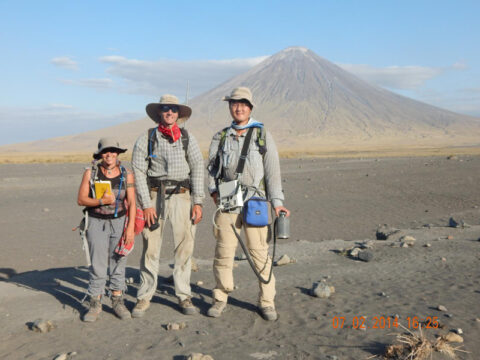Researchers have discovered a previously unknown source of carbon dioxide leaking into the atmosphere. The gas emerges from faults where the slow separation of plates of the planet’s continental crust is cracking and deforming the Earth.
Faults in the East African Rift zone release about 71 megatons of carbon dioxide (CO2) into the atmosphere every year—a value comparable to CO2 leaking from volcanic chains that stitch across the sea beds of many of Earth’s oceans and mark where new oceanic crust is forming—according to a new study published last week in Nature Geoscience.
Although researchers have long investigated the East African Rift, none of them have explored if “the Rift could release CO2 along the faults,” said Hyunwoo Lee, lead author on the paper and a doctoral student at the University of New Mexico.
The discovery of a new significant source of CO2 gives scientists a more complete picture of natural sources of atmosphere-warming CO2, said James Muirhead, a doctoral student at the University of Idaho, Moscow, and a coauthor on the study. In addition to the East African Rift zone, a handful of other continental rift zones dot the planet, such as the Basin and Range in the southwestern United States and the Eger Rift in central Europe.
“This relevant result highlights how diffuse degassing along continental rifts is a main source of carbon dioxide to the atmosphere, not considered until now.”
“This relevant result highlights how diffuse degassing along continental rifts is a main source of carbon dioxide to the atmosphere, not considered until now, which in the past, such as in the Cretaceous during widespread continental rifting, could have dramatically modified the climate of the Earth,” said Giovanni Chiodini, a researcher at the National Institute of Geophysics and Volcanology in Naples, Italy, who was not involved in the research. “Despite [CO2’s] major role in modulating Earth’s climate, we remain largely unaware of the processes governing the natural fluxes of carbon between Earth reservoirs and the atmosphere.”
However, the new source doesn’t play as major a role in influencing climate as human-driven emissions of greenhouse gases, Muirhead noted. “Even though this is a large amount, it’s still on the order of 500 times smaller than human outputs” of CO2, which exceeded 36 gigatons in 2013.
Deep Magma Bodies
Previous research found CO2 seeping from faults in Italy, which inspired Lee and his colleagues to look at the East African Rift zone (EAR). Because the EAR is so large—stretching thousands of kilometers across northeastern Africa—it offers many more faults to study.
A lot of magma can build up beneath such an extensive rift zone, “so you have the potential to produce a lot more CO2 coming into the atmosphere,” said Muirhead.
The researchers collected CO2 samples from fault zones around the Natron-Magadi region of the rift valley, at the border between Kenya and Tanzania, to assess “diffuse degassing”—seepage of small amounts of CO2 over a large area. They then analyzed the samples to determine their origins. Carbon dioxide from magma sources generally contains a higher ratio of the heavier carbon isotope, carbon-13 (13C), compared to the lighter isotope, carbon-12 (12C). Conversely, more 12C compared to 13C indicates biogenic origins. In this case, the researchers found more of the heavier isotope, which means the CO2 was originating from magma deep below the Earth’s surface.

Simultaneously, the researchers tracked seismic activity in the region, Lee said. Using an already established network of seismic instruments, the researchers observed constant earthquakes occurring deep below the crust—sometimes as deep as 30 kilometers, Muirhead said, indicating that CO2 seepage from the rift valley comes from deeper within the Earth than the CO2 spewed by active volcanoes, which are powered by magma closer to the surface. The researchers suspect that the magma bodies supplying the CO2 lie in the lower portion of the Earth’s crust or even in the upper mantle.
The researchers found that the Natron-Magadi region of the EAR releases about 4 megatons of CO2 every year. If that’s typical of the entire rift valley, then the system is releasing 71 megatons per year, the team calculated.
Mid-ocean ridges across the globe pump out about 53–97 megatons of carbon dioxide per year, but most of it dissolves into the ocean or recycles back into the Earth’s crust through subduction, Muirhead said. On land, CO2 degassing from continental rifting has no such buffer and enters the atmosphere directly.
According to Lee and his colleagues, that the EAR rivals the output of all mid-ocean ridges means that continental rifting could be a significant player in long-term shifts of Earth’s climate and that active volcanoes aren’t the only places where CO2 emerges naturally.
—JoAnna Wendel, Staff Writer
Citation: Wendel, J. (2016), Scientists discover a new source of atmospheric carbon dioxide, Eos, 97, doi:10.1029/2016EO044671. Published on 26 January 2016.
Text © 2016. The authors. CC BY-NC 3.0
Except where otherwise noted, images are subject to copyright. Any reuse without express permission from the copyright owner is prohibited.

